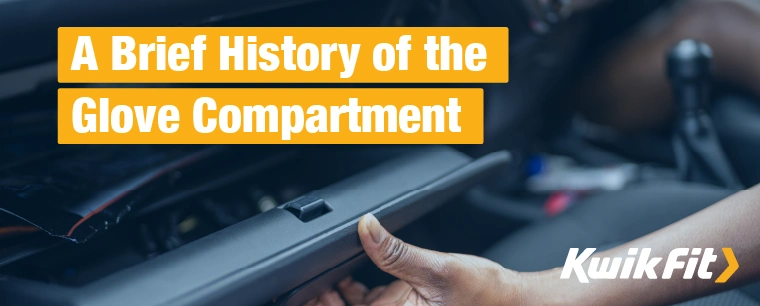A Brief History of the Glove Compartment
Jack Dreyer | Friday 20th October 2023 9:00am

Don’t you just love getting into your car after a long day of work, putting on your best driving gloves (the leather ones with red trim) and just hitting the road. No? So what in the world is the glove compartment for?
Well, originally, it actually was for gloves.
The history is surprisingly interesting.
It wasn’t always the “glove compartment”
When cars first became motorised carriages as opposed to horse-drawn carriages, they used pretty much the same fundamental designs – with the only primary difference being the distinct lack of horses. They tended to be designed with the engine underneath the two seats of the carriage.
Quite quickly, however, there was a purposeful attempt to visually separate motor-carriages from horse-drawn ones in order to give the impression of newfangled tech. The first thing to go was the “dashboard” – which was originally a barrier at the front of the carriage that protected the carriage driver from muck being “dashed up” by the horses when riding.
There was also, occasionally, a storage box under the dashboard on horse-drawn carriages. The Packard Automotive Car Company, who created the first “glove compartment” on their Packard Model B actually just kept the storage boxes that would have been commonplace before. They didn’t initially label it as a compartment specifically for gloves but for storing anything that you may need to store – including jackets and parcels.
It was actually a writer and early motorist called Dorothy Levitt who first suggested that the storage box should have gloves in it in her book The Woman and The Car – a book which, despite being over a hundred years old, actually contains a great deal of sensible motoring advice for modern motorists!

What kind of gloves were they?
The removal of the dashboard coupled with the fact that early carriages were almost all open-topped (though, by today’s terminology, “convertible”) meant that your hands would get chilly really quickly. If you’ve ever cycled fast in cold weather or driven a motorbike without gloves, you’ll know how quickly this can happen.
This, other than being uncomfortable, can actually be quite dangerous if it gets to the point that you can’t move your hands properly!
So “driving gloves” were originally ones made to keep your hands warm but also tended to be made from soft leather so that you could maintain grip on the steering wheel. Because many steering wheels on early motor cars were made entirely from either metal, wood, or ivory, they could often be freezing in the winter and sweat-soaked in the summer.
But driving gloves weren’t just a comfort luxury. Early cars were considerably less reliable than those of today so drivers needed to perform constant maintenance and repair. Indeed, you’d have to start the car by manually cranking the engine. With punctures, oil checks, and manual starts being daily occurrences, you’d often find your hands filthy after even a short drive.
A bit of car grease may not sound so bad but, unless you clean your car very regularly, even topping up the air can leave your hands filthy – which isn’t a great way to turn up to work (or the latest high-society get-together)!
Frequently, then, there’d be a pair of mucky gloves and a separate pair of not-so-mucky driving gloves.
What about the glove compartment since then?
All this is well and good, but we’ve had heated-interior cars for about a hundred years now – why do we still call it the glove compartment? Well, why not? We still call it the “dashboard”, we still call it a “carriage”, and we still measure engines by “horsepower”.
Sometimes, things just stick.
There have been some really wacky ideas for glove compartments; to really hammer home the luxury angle, the 1957 Cadillac Eldorado Brougham had a mini cocktail bar in the glove compartment. Of course, that seems like a great touch… but a single malt whiskey on the rocks is absolutely not the right refreshment during a long drive.
There was a brief phase of heating and/or cooling the glove boxes so that you could keep (non-alcoholic) refreshments in it but, for the most part, the glove box has remained pretty much what it was always intended for: a space to store parcels, waterproof jackets, first aid kits, tissues, old receipts, a tyre iron, repair manuals, and a partridge in a pear tree.
For more motor-curiosity content, as well as tons of useful information on anything from car cleaning to general maintenance, head to our blog.
And if your car’s giving you trouble, get in touch with your local Kwik Fit centre for expert advice.
Any facts, figures and prices shown in our blog articles are correct at time of publication.
Featured Articles
Is it Illegal to Drive With One Headlight?
Saturday 19th July 2025
Wondering if it’s illegal to drive with one headlight? Learn about the safety risks and penalties of illegal blown bulbs and why you should fix them promptly.
Air Con in EVs & Hybrids: Experts Answer Your Questions
Monday 30th June 2025
Does air con drain EV batteries? Can you use the air con while charging an electric car? Find out the answers to these questions & more from Kwik Fit’s experts.
Why Is Your Car Making a Noise? Fixes & Tips
Friday 13th June 2025
When your car starts making unexpected noises, it can certainly be quite disconcerting; it may be nothing to worry about, but here’s what you need to know.









